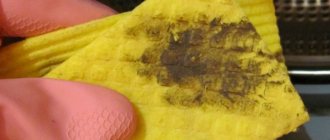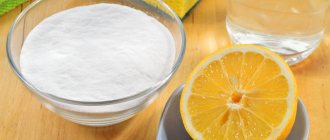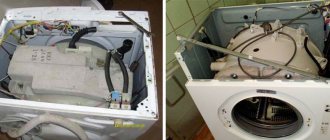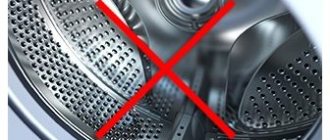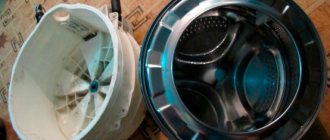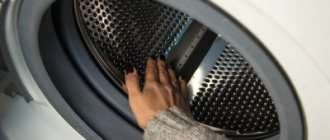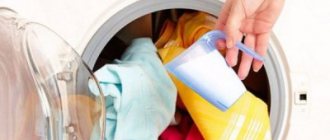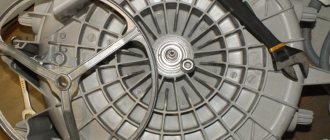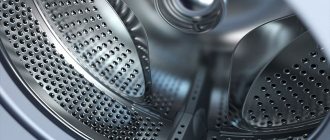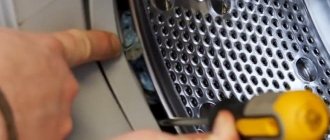Modern washing machines equipped with program control have many advantages compared to semi-automatic devices.
Regardless of what model of device you own, the problem of the negative impact of hard water on unit parts remains relevant.
Care instructions
Periodic cleaning of the drum is just one link in a whole chain of unit care procedures.
IMPORTANT! This element of the device can be called a kind of indicator, which is convenient for determining whether other parts of the machine need cleaning.
Look into the drum and inspect it carefully - if there are traces of scale or dirty deposits on the walls, then the internal parts of the device will be in even worse condition, and cleaning should be started immediately.
Learn more about how to clean elastic in the washing machine.
In addition to the drum, the following parts require regular maintenance:
- drainage system (filter and hose);
- water supply system to the unit (inlet filter, hose);
- rubber seal located between the device door and the drum;
- heating element.
Causes of odor and dirt in washing equipment
Even a new machine begins to emit an unpleasant odor after a short time. This happens because the dirt that is washed from clothes most often settles on the parts of the machine. It remains on the seal, filter and in the drain hose. Usually the cause is a low washing temperature, which is simply not able to break down grease and dirt. Over time, these deposits accumulate, stagnate and encourage the development of harmful bacteria. They are the ones that cause the unpleasant odor. After a short time, mold and mildew develop. As a result, freshly washed items no longer smell clean. If you leave the finished wash in the drum for some time, it will acquire a specific musty smell.
Contrary to popular belief, more powder and rinse aid do not improve washing, but harm the device. Excess also settles on parts and causes problems in the near future.
Pins, laces, pieces of paper, threads, coins and other small items get stuck in the hose, becoming an additional cause of debris accumulation. This is especially true when a furry pet lives in the house or a lot of woolen items are washed. One way or another, dirt, lint, small debris and hair will certainly accumulate on the inner surface of the machine, so regular cleaning of the washing machine is more than necessary.
How are lime and mineral deposits formed?
Surface and groundwater (sources of water supply to consumers) are significantly enriched with various mineral salts, including calcium and magnesium. The greater the quantitative content of these elements in a liquid, the greater its hardness.
Therefore, in most households, during the operation of household appliances, hard water is used , which has a negative impact on the condition of their internal parts and components: calcium and magnesium ions, when heating water in a washing machine, form special compounds that settle on the heating elements and the drum of the device.
As a result, the unit requires more energy to perform the wash. Solid deposits cause rusting of the metal parts of the device and damage the insulation, which can cause a short circuit during operation of the equipment.
You can learn how to get rid of mold in your washing machine here.
Scale can also lead to the following problems:
- overheating of the tubular electric heater;
- unbalance of the washing machine drum.
Did your washing machine break down due to scale?
Not really
REFERENCE! In addition to the detrimental effect on electrical appliances, hard water, reacting with detergents that are added during the washing process, leaves a grayish coating on things, deteriorates the quality of fabrics and reduces the strength of the material.
What else needs to be cleaned?
Through the hatch opening it is possible to visually inspect the condition of the device.
You can remove the top cover to examine in detail the condition of the drum outside. This will allow us to draw a conclusion about the technical condition of the entire device. If plaque and dirt are visually noticeable on the drum, then there is much more of it on the heating element.
To extend the life of your washing machine, you need to clean:
- Water drain path and drain filter.
- Loading hatch cuff.
- Tank from the inside.
- Heating elements.
- Drum pulley.
After each wash, be sure to clean the drain filter, as a large amount of dirt accumulates in it. In addition, solid debris may remain there, which will cause blockage and problems with further drainage of water.
The cuff should also be cleaned of dirt. It often contains remnants of fabric, fine dirt, and other solid elements. If you leave them there, there is a risk of damaging the rubber parts the next time you wash them. Then the machine will leak.
Preparation
Before carrying out the procedure, carefully read the operating instructions for the device and consider which product will be optimal for use in your particular machine model.
Precautionary measures
Special cleaning products should be used with extreme caution and strictly adhere to the dosage recommended by the manufacturers. Otherwise, the product may damage the metal, rubber or plastic elements of the device.
The same rule applies to cleaning the device using traditional methods . So, for example, when using citric acid, it is unacceptable to start the unit at a temperature of more than 80 ⁰C or fill the receiving tray with a large amount of product.
Self-cleaning washing machines
Most modern models of washing machines from the brands LG, Samsung, Haier, Hotpoint, Electrolux, Gorenje, Haier, Ariston, Beko, Indesit and many others are equipped with a self-cleaning function.
For example, the BEKO WMI71241 model - with its classic design and maximum load of up to 7 kilograms of laundry, is equipped with a self-cleaning program - that is, washing with an empty drum at high temperature without detergents.
The LG F-1296ND3 model, a very popular built-in model designed to load 6 kg of laundry, also has this capability.
Manufacturers of the LG brand have made a special series “Direct Drive” - the models of which have at least 10 programs (depending on how much the car costs, their number varies), among which there is self-cleaning.
How to clean dirt from the inside?
The best option for keeping the machine drum clean is to alternately use professional and homemade products.
Special formulations can be bought at any household chemicals store; the most effective means at hand are:
- baking soda;
- lemon acid;
- vinegar essence;
- White.
ATTENTION! When choosing a product, be guided by the degree of contamination of the drum and the need to eliminate other problems.
If, in addition to plaque, an unpleasant odor appears in the machine, it is better to clean it with vinegar or citric acid. Soda will remove plaque perfectly, but it will be difficult to get rid of the musty smell.
Vinegar essence
This product is a very popular means of cleaning any household appliances, including a washing machine.
Using an acidic drug has a number of advantages:
- effective descaling, disinfection of surfaces, elimination of unpleasant odors;
- During the procedure, the heating element is cleaned simultaneously with the drum.
ADVICE! To remove scale you will need table vinegar (9%). If you use essence, dilute it with water (1:10, respectively), since in its pure form the liquid can cause irreparable harm to the rubber and plastic parts of the device.
Sequence of the procedure:
- make sure that there are no things in the drum of household appliances;
- pour 200 ml of the prepared acidic solution into the reservoir intended for storing fabric softener;
- turn on the device, set the long washing mode and high water heating temperature;
- after 10 minutes, stop the device by pressing the pause button;
- After an hour, during which the drug has time to dissolve solid deposits, continue the washing process.
IMPORTANT! Once the unit has completed its cycle, run an additional rinse to remove any remaining sediment and vinegar from the unit. After this, leave the device with the door open so that the strong smell of the product disappears.
Baking soda
Quite effective in removing various contaminants. But in order to remove scale, the use of baking soda will be effective only if the amount of solid deposits in the machine is insignificant :
- moisten the drum walls with a damp sponge;
- dip a rag in baking soda powder and thoroughly wipe all surfaces of the part;
- leave the car for half an hour, then use a damp sponge to remove the soda from the walls;
- close the unit door, turn on the appliance in rinse mode to remove any remaining product.
High-quality descaling can be done using soda ash:
- mix the drug and water in equal proportions in a small bowl;
- Apply the resulting product with a sponge to the inner surfaces of the drum, close the door;
- after half an hour, wash off the plaque, turn on the device for the shortest washing cycle (without laundry).
White
Using regular Whiteness is one of the most inexpensive and effective methods of cleaning a washing machine drum. Also, any product containing chlorine is suitable for removing plaque.
IMPORTANT! With this product, you will not only remove mineral and lime deposits in the device, but also get rid of various pathogenic microorganisms, including mold.
Follow these steps:
- into the receiving tray intended for liquid detergents, pour Whiteness diluted in equal parts with water;
- run a long wash (at maximum temperature);
- just like when using vinegar, after 10 minutes from the start of operation of the device, turn on the pause;
- after an hour, continue washing;
- At the end of the program, start the rinse mode (do this twice).
IMPORTANT! The method using chlorine-containing preparations to remove scale in the drum of household appliances can be used no more than once every 12 months.
Lemon acid
- pour the acid into the machine (put the drug directly into the drum or place the product in the powder receiving tray);
- start the wash (temperature up to 80°C, washing mode should include rinsing and spinning);
- After the cycle is completed, open the door and carefully inspect the sealing tape - there may be acid residues on it. If necessary, remove the product with a dry cloth.
IMPORTANT! To clean a drum with a capacity of less than 4 kg, you will need 60 g of citric acid; if the volume of the element is larger, add 100 g of the product.
How does the drum clean function work?
Cleaning looks like a regular wash without laundry and consists of several stages:
- The pre-wash mode is activated.
- The main mode or cleaning starts at 60 degrees with speeds up to 150 rpm.
- The program ends with a double rinse and a spin at the highest possible speed.
To prevent the formation of plaque and clogging, it is enough to carry out preventive cleaning of the drum twice a month. We strongly recommend that you clear the drain filter of debris before starting this function.
Important! Using this cycle does not remove or prevent scale.
Special cleaning products
Chemical preparations not only effectively remove hard deposits, but also prevent further formation of scale in the drum and on other parts of the device.
The most popular are the following:
- Frisch Active is a high quality German drug. To descale, pour half a cap into the detergent tray and another half cap into the drum. Turn on the wash (without laundry), set the maximum temperature, and pause after 10-15 minutes. After an hour and a half, complete the washing program, then turn on the rinse mode.
- Dr. Beckmann is also a German remedy. Directions for use: pour 250 g of the product into the drum, start the wash (at a temperature of 60-90 ° C, without laundry and other detergents). There is no need to rinse after cleaning.
- Topper Express descaling cleaner - designed to remove hard deposits from the drum and heating elements of washing machines, and clean dishwashers. Method of use: pour the powder contained in the package into an empty drum, turn on the wash at a temperature of 60 ⁰C (without pre-soaking), let the device complete the program to the end.
- Calgon – add this product along with the powder every time you wash your clothes. The drug helps soften water and prevents scale formation. The amount of product depends on the hardness of the water used for washing: if the indicator is low, add 32 ml (1/3 measuring cup) of Calgon, medium hardness – 64 ml, high hardness – add a full measuring cup (96 ml). The drug should be placed in the same tank where the washing powder is poured. It is not recommended to place the product directly into the drum.
What means will you use?
FolkSpecial
Self-cleaning washing machine
The eco drum cleaning function does not require the addition of any cleaning agents or disinfectants; the machine cleans everything on its own. The cleaning cycle is carried out at a temperature of 70 degrees for 90 minutes.
This allows you to disinfect the inside of the device, remove scale, mold and unpleasant odors - it is impossible to change these parameters, they are set automatically by the electronics of the washing machine.
The eco-drum cleaning program makes it possible not only to maintain hygiene inside the device, but also significantly extends the performance of the unit. In addition, by regularly cleaning the washing machine, you will save energy, because the electric heater is also cleaned of plaque adhering to it, and, therefore, heats the water much faster and more efficiently.
Useful tips
To reduce the entry of dirt, foreign objects, sand into the drum and prevent the formation of scale on this element, adhere to the following preventive measures :
- before placing things in the drum, first remove all foreign objects from pockets, clean clothes from dried-on dirt and lint;
- Shake bed linen thoroughly several times before washing to get rid of dust particles;
- wash things by placing them in special bags made of thin fabric;
- Install a magnetic water softener on the machine's inlet hose or inlet pipe, which effectively removes calcium and magnesium salts from the liquid. Thus, soft water will flow into the device, which will completely solve the problem of scale in the drum and on the heating element.
IMPORTANT! Cleaning the unit from lime and mineral deposits should be carried out once every 6 months.
This procedure will ensure reliable and uninterrupted operation of the washing machine for a long time.
Washing hygiene
Automatic washing machines are designed to save the owner from unnecessary hassle. But are they really independent? You load clothes into the drum, add powder, press a button and after a while you get clean clothes. Particles of dirt, lint, threads and pet hair remain in the drum.
Only part of this small debris enters the filtration system and is discharged into the sewer. Tiny fractions settle on the walls, where they become an ideal environment for the proliferation of pathogenic fungi and bacteria.
You load new clothes, and all this microflora ends up on things, because the standard washing mode involves heating the water only in the range of 30-60°C. This temperature is not enough to kill pathogens.
Preventing scale formation
Of course, it will not be possible to avoid the appearance of scale. No matter how soft the water is in the region where you live, it will still appear (just a little slower). So you can only delay its formation by using special filters and water softeners.
IMPORTANT! Do not forget about regular general cleaning of the washing machine and all its elements.
Cleaning the cuff (sealing rubber)
This is one of the most favorable places in home appliances where mold likes to appear. Dirt and water residues often accumulate in cuffs after washing. When cleaning the washing machine, special attention is paid to the rubber seals.
Drum cleaning
Cuffs can be cleaned using various special household chemicals, as well as some folk methods. If you start the situation, a large amount of fungus will accumulate here, which can only be removed with the help of:
- Pemolux;
- Domestos;
- Duckling;
- Comet;
- Whiteness.
The main thing when cleaning rubber parts is not to use chlorine-containing products. They may cause product deformation.
Cleaning the powder tray
Cleaning the cuffs is carried out as follows:
- Apply a little household chemical to the sponge.
- All rubber is carefully processed with a sponge.
- Then you need to pull off the rubber band and wipe the metal elements of the case located behind it.
Particular attention should be paid to the lower part of the hatch. Usually dirt and mold accumulate in it.
